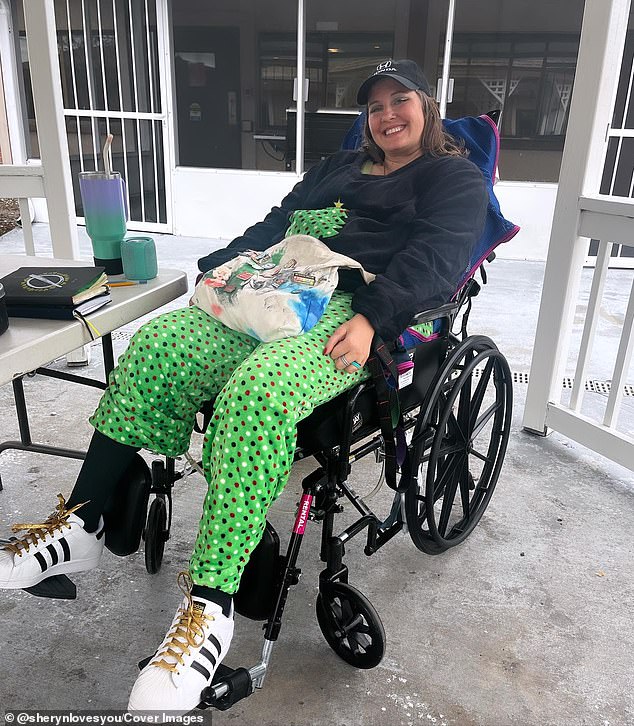Florida woman, 38, warns of risks of psychedelics after throwing herself down a stairwell with LSD, leaving her paralyzed from the neck down
A Florida woman has warned about the dangers of psychedelics after falling down a flight of stairs during a drug-induced frenzy and becoming paralyzed from her armpits down.
Sheryn Jamelle Brown, now 38, of Orlando, had taken three hits of the drug LSD when she fell from the top of a flight of stairs and broke two vertebrae in her spine.
The devastating act was fueled by a sense of disorientation and an unsafe feeling in her environment.
“I felt a shock of fear go through my body like lightning,” she said.
Today, Sheryn lives in a nursing home and requires full-time care with daily tasks such as washing, dressing and preparing food.
Sheryn Jamelle Brown, now 38, said she considered medically assisted suicide because she had to undergo months of physical therapy after the injury that left her paralyzed.
She sees herself as a “warning” to others, not only about the dangers of drugs, but also about the risks of being too eager to please others.
“My desire to please, my ego and peer pressure all played a role in me becoming paralyzed,” she said.
“I want to be that warning to everyone else to respect themselves at all times.”
On Valentine’s Day 2016, Sheryn, then 30, was traveling with friends and her ex-girlfriend in India when she took three hits of the hallucinogenic LSD.
She had used the drug twice before, but was hesitant to do it again.
Sheryn said her partner pressured her to accept the hits an hour apart. While she felt a ‘deep’ sense of openness and love, she became disoriented and fearful of her surroundings.
She said: ‘I told my ex-girlfriend and the other girls that I was afraid for my own safety. But my ex-girlfriend insisted that we go on to a night market.”

Sheryn, pictured here in the hospital shortly after her fall, is one of the 18,000 Americans who suffer a spinal cord injury each year

“While I want to be that warning to all others to respect themselves at all times, my journey is more than just highlighting the dangers of drugs,” Sheryn said
But in a state of disorientation, she threw herself over the stairs leading to the loft bed in her hotel room, breaking the C6 and C7 vertebrae in her neck.
“I woke up, still stumbling, naked and covered in bruises and abrasions, with two black eyes, and unable to move except for a blow to my right hand,” Sheryn said.
She became one of 18,000 Americans who suffer from spinal cord injuries each year, or about 54 per million people. According to the Christopher & Dana Reeve Foundation, approximately two percent of the population has some form of paralysis.
Spinal cord injury is the second most common cause of paralysis in the US, just behind a stroke.

Sheryn said she had tried LSD twice before in her life and was hesitant to do it again, but succumbed to the peer pressure she felt from her former partner.

Before the fall, Sheryn was an avid runner. She now lives in a care home and relies on 24-hour support for all her daily tasks
Sheryl says her partner refused to take her to hospital and when she finally got there, a surgeon had to come from five hours away to offer specialist treatment.
“The doctors and others were disgusted with me because I was using drugs,” she said. “My guilt and shame quickly increased.”
Despite struggling with deep depression and suicidal feelings in the months after her accident, Sheryn said the support from her family and friends gave her a “new direction.”
“They all pushed me to choose life no matter what,” she said.
She is also learning to deal with the way she became paralyzed and is undergoing rehabilitation therapy.
Rehabilitation after paralysis usually aims to improve mobility and help people learn to adapt to life without full movement of their body.
LSD, or lysergic acid diethylamide, has psychedelic effects because it disrupts the release of the hormone serotonin in the brain, which is responsible for regulating mood and perceptions.
It is thought that the change in serotonin may provide benefits such as improving mood and relieving anxiety.
The way the drug binds to cells in the brain can also alter communication between neurons, causing visual and auditory hallucinations.
LSD is currently illegal, but has been the subject of clinical trials into its possible use for anxiety relief.
In March, the FDA granted a form of psychedelic “breakthrough therapy” status, which speeds the review and approval process of promising new drugs.
This followed results from a trial of 194 volunteers which found that 100 micrograms of LSD – the same as the average recreational dose – significantly reduced anxiety in half of patients taking the drug.
However, there is fierce criticism of the possible use of LSD for medical purposes due to the serious risks.
After just one dose of LSD, a disturbing condition called “hallucinogenic perception disorder” can develop, involving chronic and sporadic hallucinations.
Taking the drug is also known to increase the risk of developing serious psychiatric disorders such as schizophrenia.
